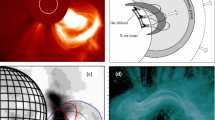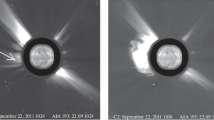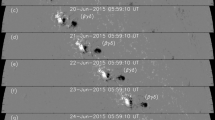Abstract—
The dynamics of the preflare phase of microwave and ultraviolet emission for M-class X-ray flares in three active regions (ARs), two flares with coronal mass ejections (CMEs) and one flare without a CME, were considered. Extrapolation of the magnetic field in the AR corona showed that eruptive events were associated with the formation of a twisted magnetic field (magnetic flux rope) and with an open magnetic configuration at the flare site in two ARs with CMEs under consideration, while the flare without a CME was observed in a closed magnetic configuration.






Similar content being viewed by others
REFERENCES
Bakunina, I.A. and Melnikov, V.F., Dynamics of solar microwave emission before powerful flares in September 2017, Astron. Astrophys. Trans., 2019, vol. 31, no. 3, pp. 251–266.
Bakunina, I.A., Melnikov, V.F., and Morgachev, A.S., Preflare dynamics of microwave and ultraviolet emission in active regions of the Sun, Astrophysics,2020a, vol. 63, no. 2, pp. 252–259.
Bakunina, I.A., Melnikov, V.F., and Morgachev, A.S., Signs of preflare situation in solar ultraviolet and microwave emission, Geomagn. Aeron. (Engl. Transl.), 2020b, vol. 60, no. 7, pp. 853–859.
Bakunina, I.A., Melnikov, V.F., Shain, A.V., et al., Spatial and temporal features of the behavior of microwave and ultraviolet emission for eruptive events, Izv. Krym. A-strofiz. Obs., 2022, vol. 117, no. 1, pp. 65–74.
Carmichael, H., A process for flares, in The Physics of Solar Flares, Proceedings of the AAS-NASA Symposium held at the Goddard Space Flight Center, Greenbelt, Md., 28–30 October, 1963, Hess, N.H., Washington, DC: National Aeronautics and Space Administration, Science and Technical Information Division, 1964, pp. 451–456.
Cheng, X., Ding, M.D., Zhang, J., et al., Formation of a double-decker magnetic flux rope in the sigmoidal solar active region 11520, Astrophys. J., 2014a, vol. 789, id 93.
Cheng, X., Ding, M.D., Zhang, J., et al., On the relationship between a hot-channel-like solar magnetic flux rope and its embedded prominence, Astrophys. J. Lett., 2014b, vol. 789, id L35.
Eselevich, V.G., The origin of coronal mass ejections: The current state and recent results, Izv. Krym. Astrofiz. Obs., 2016, vol. 112, no. 1, pp. 47–57.
Filippov, B.P., Eruptivnye protsessy na Solntse (Eruptive Processes on the Sun), Moscow Fizmatlit, 2007.
Filippov, B.P., Gopalswamy, N., and Lozhechkin, A.V., Motion of an eruptive prominence in the solar corona, Astron. Rep., 2002, vol. 46, pp. 417–423.
Gibson, S.E., Fan, Y., Török, T., and Kliem, B., The evolving sigmoid: Evidence for magnetic flux ropes in the corona before, during, and after CMEs, Space Sci. Rev., 2006, vol. 124, pp. 131–144.
Hirayama, T., Theoretical model of flares and prominences. I: Evaporating flare model, Sol. Phys., 1974, vol. 34, pp. 323–338.
Kliem, B. and Török, T., Torus instability, Phys. Rev. Lett., 2006, vol. 96, id 255002.
Kliem, B., Titov, V.S., and Török, T., Formation of current sheets and sigmoidal structure by the kink instability of a magnetic loop, Astron. Astrophys., 2004, vol. 413, pp. L23–L26.
Kopp, R.A. and Pneuman, G.W., Magnetic reconnection in the corona and the loop prominence phenomenon, Sol. Phys., 1976, vol. 50, pp. 85–98.
Sharykin, I.N., Zimovets, I.V., and Myshyakov, I.I., Flare energy release at the magnetic field polarity inversion line during the M1.2 solar flare of 2015 March 15. II. Investigation of photospheric electric current and magnetic field variations using HMI 135 s vector magnetograms, Astrophys. J., 2020, vol. 893, id 159.
Shen, Y., Liu, Y., and Su, J., Sympathetic partial and full filament eruptions observed in one solar breakout event, Astrophys. J., 2012, vol. 750, id 12.
Sterling, A.C. and Moore, R.L., Slow-rise and fast-rise phases of an erupting solar filament, and flare emission onset, A-strophys. J., 2005, vol. 630, pp. 1148–1159.
Sturrock, P.A., Model of the high-energy phase of solar flares, Nature, 1966, vol. 211, pp. 695–697.
van Ballegooijen, A.A. and Martens, P.C.H., Formation and eruption of solar prominences, Astrophys. J., 1989, vol. 343, pp. 971–984.
Wiegelmann, T., Optimization code with weighting function for the reconstruction of coronal magnetic fields, Sol. Phys., 2004, vol. 219, pp. 87–108.
Zhang, J., Wang, J., Deng, Y., and Wu, D., Magnetic flux cancellation associated with the major solar event on 2000 July 14, Astrophys. J., 2001, vol. 548, id 744.
Zhang, J. and Dere, K.P., A statistical study of main and residual accelerations of coronal mass ejections, Astrophys. J., 2006, vol. 649, pp. 1100–1109.
ACKNOWLEDGMENTS
The work was performed using data from the Nobeyama Radioheliograph, which was operated by the International Consortium for the Continued Operation of Nobeyama Radioheliograph (ICCON). ICCON includes the ISEE/Nagoya University, NAOC, KASI, NICT, and GSFC/NASA. We are grateful to the SDO team for the AIA and HMI observational data. The flare catalog is available at NOAA, Space Weather Prediction Center at ftp://ftp.ngdc.noaa.gov/ STP/swpc_products/weekly_reports/PRFs_of_SGD/. Programs for nonlinear force-free extrapolation of the magnetic field into the solar corona were developed by S.A. Anfinogentov and A.G. Stupishin and are available at https://github.com/Sergey-Anfinogentov/GXBox_prep, https://github.com/Alexey-Stupishin/Magnetic-Field_ Library.
Funding
This work was supported by the Russian Foundation for Basic Research–Czech Republic, project no. 20-52-26 006 (A.V. Shain), Russian Science Foundation, project no. 22-12-00308 (V.F. Melnikov), and State Task, project no. 1021032422589-5 (V. E. Abramov-Maхimov).
Author information
Authors and Affiliations
Corresponding author
Ethics declarations
The authors declare that they have no conflicts of interest.
Additional information
Translated by O. Pismenov
Rights and permissions
About this article
Cite this article
Bakunina, I.A., Melnikov, V.F., Shain, A.V. et al. Analysis of the Preflare Phase of Eruptive and Noneruptive Flares Using Data on the Spatial Dynamics of Coronal Magnetic Structures and Their Microwave and Ultraviolet Emission. Geomagn. Aeron. 62, 1066–1072 (2022). https://doi.org/10.1134/S0016793222080047
Received:
Revised:
Accepted:
Published:
Issue Date:
DOI: https://doi.org/10.1134/S0016793222080047




